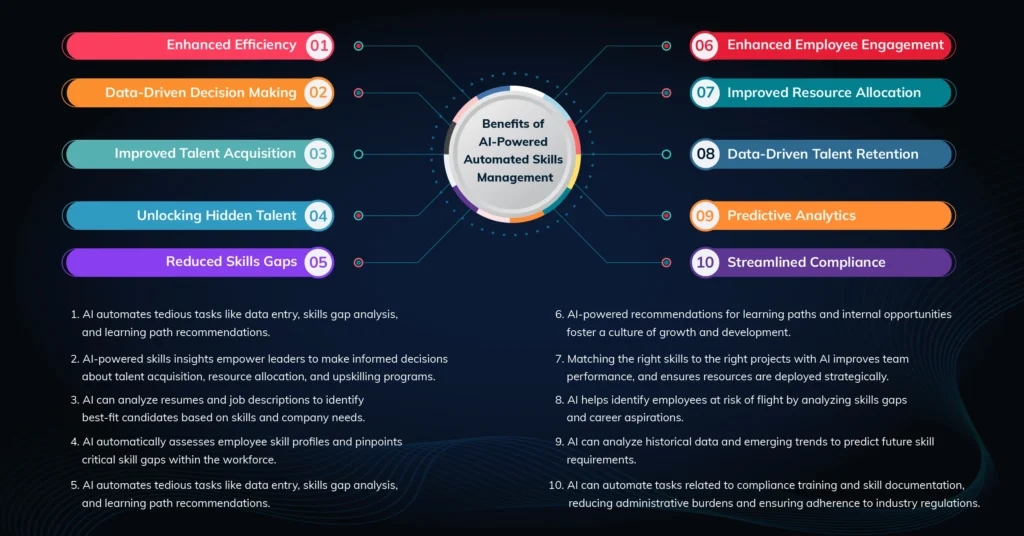Skills management is a critical operation for any organization. For managing your workforce effectively, hiring the best talent, and building a pipeline for the future, skills management is the common denominator for all. But just like the relics of the technological past, traditional skills management systems are struggling to keep pace with the dynamic world of work. These outdated approaches, reliant on manual processes and rigid frameworks, leave workforce managers drowning in spreadsheets and static dashboards, yearning for a more efficient solution.
The skills required for success today are more complex and ever-evolving than ever before. Static skill inventories and subjective self-reported data simply don’t cut it anymore. This blog post dives into the critical shortcomings of traditional skills management and explains how an AI-powered solution is a solution that empowers organizations to move beyond the limitations of the past and thrive in a skills-first future.
The Limitations of Traditional Skills Management
Many organizations rely on manual and static methods for managing employee skills. These often involve spreadsheets, surveys, and self-reported data. While these approaches may work for extremely small teams, they quickly become cumbersome as organizations scale.
Here are some key challenges associated with manual skills management:
Inefficiency: Manual data entry and analysis are time-consuming and resource-intensive. This limits the ability to maintain an accurate and up-to-date skills inventory.
Lack of Scalability: Manual processes are not scalable to large and diverse workforces. Keeping track of skills becomes increasingly difficult as the organization grows.
Limited Insights: Traditional methods offer limited insights into skill gaps and talent distribution. This makes it difficult to plan effectively for reskilling and talent mobility.
Inaccuracy: Self-reported data is prone to bias and subjectivity. Employees might overestimate their skills or struggle to articulate them effectively.
These limitations can have a significant impact on an organization’s ability to:
- Hire the right talent: Inefficient skills management hinders the ability to identify and attract candidates with the required skillsets.
- Develop the existing workforce: Without a clear picture of employee skills, it’s challenging to create targeted learning and development programs.
- Optimize resource allocation: Difficulty in matching skills to projects can lead to inefficiencies and underutilized talent.
- Planning a future talent pipeline: Inaccurate and hefty skills management prevents workforce planning to progress into proactive talent management. It keeps the process highly demand-based leading to urgent role-based hiring decisions.
So what is the right solution to overcome these challenges?
AI-Powered Automated Skills Management: A Game-Changer for the Modern Workforce
AI-Powered Automated Skills Management represents a revolutionary shift in how organizations approach talent development and resource allocation.
AI-Powered Automated Skills Management uses AI to analyze data, create a comprehensive skills framework, automate tasks like skill gap analysis and learning recommendations, and foster a talent marketplace for optimal resource allocation and employee development.
Imagine a system that intelligently analyzes vast amounts of data to create a comprehensive skills framework of your organization. This framework goes beyond basic job titles and delves into the specific skill set needed for every role in the organization.
AI algorithms then leverage this data to automate critical tasks, such as generating accurate employee skill profiles, identifying skill gaps, and recommending personalized learning pathways for each employee.
AI-powered automated skills management doesn’t stop there. It fosters a dynamic talent marketplace within your organization, connecting employees with internal opportunities that not only align perfectly with their skill set and career aspirations, but also your company’s future development goals.
This empowers individuals to take ownership of their professional development while ensuring the right talent is deployed to the right projects at the right time. By streamlining workflows, improving data accuracy, and providing actionable insights, automated skills management empowers workforce managers to become strategic partners in building a future-proof talent strategy.
Benefits of AI-Powered Automated Skills Management
Enhanced Efficiency
AI automates tedious tasks like data entry, skills gap analysis, and learning path recommendations. This frees up valuable time for HR professionals and managers to focus on strategic initiatives, talent development coaching, and fostering a positive work environment.
Data-Driven Decision Making
AI-powered skills insights empower leaders to make informed decisions about talent acquisition, resource allocation, and upskilling programs. No more flying blind – data becomes the foundation for strategic workforce planning.
Improved Talent Acquisition
Filling vacancies with the right talent becomes faster and more cost-effective. AI can analyze resumes and job descriptions to identify best-fit candidates based on skills and company needs. This reduces time-to-hire, enables faster expert matching, improves offer acceptance rates, and optimizes recruitment spend.
Unlocking Hidden Talent
AI can uncover hidden talent within your organization. By identifying the true skill set of your employees, you can identify individuals who may be underutilized or a perfect fit for upcoming growth projects. This fosters internal mobility and keeps your top talent engaged.
Reduced Skills Gaps
AI automatically assesses employee skill profiles and pinpoints critical skill gaps within the workforce. It can also proactively develop targeted training programs and upskilling initiatives to close those gaps and ensure the workforce is prepared for future challenges.
Enhanced Employee Engagement
A transparent skills management system empowers employees to take ownership of their career development. AI-powered recommendations for learning paths and internal opportunities foster a culture of growth and development, leading to a more engaged and motivated workforce.
Improved Resource Allocation
Matching the right skills to the right projects becomes effortless with AI. This optimizes project outcomes, improves team performance, and ensures resources are deployed strategically.
Data-Driven Talent Retention
AI helps identify employees at risk of flight by analyzing skills gaps and career aspirations. This allows organizations to create targeted retention strategies that address employee needs and foster a sense of belonging.
Predictive Analytics
AI can analyze historical data and emerging trends to predict future skill requirements. This allows organizations to be proactive in developing talent pipelines and preparing their workforce for the evolving needs of the business.
Streamlined Compliance
AI can automate tasks related to compliance training and skill documentation, reducing administrative burdens and ensuring adherence to industry regulations.
How Spire.AI’s AI-Driven Solution Addresses Combats the Challenges of Traditional Skills Management
Spire.AI offers a comprehensive AI-powered solution that addresses the limitations of traditional skills management. Its core technology is a domain-intelligent Generative Skills AI Platform that automates various talent management functions. Here’s how Spire.AI helps organizations overcome the challenges mentioned above:
- Auto-Evolving Role-Skill Framework: Spire.AI replaces static, manually maintained frameworks with an auto-evolving, AI-powered system. This framework automatically identifies complex skill mixes for different roles at various levels (base, enhanced, expert). This ensures the framework stays relevant and adapts to changing skill requirements.
- AI-Generated Employee Skill Profiles: Spire.AI leverages AI to generate skill profiles for employees based on minimal input (e.g., job title). You can generate accurate employee skill profiles for more than 83% of your workforce. Furthermore, employees and their managers can validate these profiles for accuracy and transparency. This eliminates the need for manual data entry and ensures a high degree of accuracy.
- Data-Driven Talent Management: Spire.AI provides a holistic view of an organization’s skill landscape. This data can be used for various talent management initiatives, such as:
- Career Path Simulations and Reskilling Recommendations: Employees receive personalized recommendations for upskilling and reskilling based on their aspirations, growth opportunities, and the company’s strategic direction.
- Live Internal Talent Marketplace: This platform facilitates internal mobility by connecting employees with relevant opportunities based on their skillsets and company needs. Previous users have witnessed an increase in internal mobility from 21% to a staggering 56%.
From Spreadsheets to Skillscapes: It is Time to Let AI Transform Skills Management
AI-Powered Automated Skills Management is not just a trendy buzzword; it’s a transformative force. Imagine a system that automates tedious tasks, generates accurate skill profiles, and empowers employees to take control of their development. Imagine a talent marketplace within your organization, connecting individuals with perfect-fit opportunities. This is the reality unlocked by AI-Powered Automated Skills Management.
AI-Powered Automated Skills Management empowers organizations to proactively tailor learning programs and upskilling initiatives to address specific skill deficiencies. This ensures your workforce is equipped to handle future challenges and positions your organization for long-term success.
But the benefits extend beyond efficiency. AI-Powered Automated Skills Management fosters a culture of learning and growth by empowering employees to become active participants in their career development. Personalized career pathways and a dynamic internal talent marketplace connect individuals with growth opportunities that align with their skills and aspirations. This fosters engagement, reduces churn, and keeps your top talent motivated and thriving.
The future of work belongs to organizations that embrace a skills-based approach. AI-Powered Automated Skills Management is not just a trend; it’s the key to unlocking the hidden potential within your workforce. By leveraging AI, you can transform your talent management strategy from a cumbersome task to a strategic advantage, propelling your organization to the forefront of the competitive landscape.
Ready to ditch the spreadsheets and embrace a Skillscape? Spire.AI’s AI-powered solution can help you unlock the full potential of your workforce. Contact us today to learn more!







